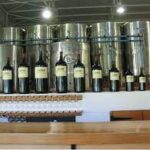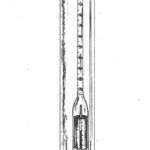Określanie kwasowości wina.
O ile cukier jest podstawą późniejszej zawartości alkoholu, o tyle kwas kształtuje aromat i smak wina. Oba czynniki muszą występować w korzystnym stosunku względem siebie. Taki harmonijny stosunek występuje tylko w dobrych latach i tylko w przypadku winogron i jabłek. W normalnych latach trzeba trochę dopomóc naturze. Nie ma w tym nic nagannego; któż może wpłynąć na niekorzystne warunki klimatyczne, panujące u nas, w Europie Środkowej?
Dokładną analizę zawartości kwasu w soku lub w winie może przeprowadzić jedynie laboratorium specjalistyczne.
Tego rodzaju dokładne badania nie są jednak konieczne przy winie domowej roboty. Całkowitą kwasowość wina lub soku określamy za pomocą kwasomierza.
Kwasomierz składa się z cylindrycznego naczynia szklanego o pojemności 20 ml z podziałką w stopniach- Oprócz tego potrzebne są: butelka niebieskiego ługu (roztwór mianowany) oraz opakowanie papierków lakmusowych.
Pomiaru dokonuje się w następujący sposób: niebieski ług w płynie dodaje się do soku lub wina tak długo, aż wino lub sok zneutralizują go. Oznacza to, że ilość kwasu musi być taka sama jak ilość ługu. Neutralizację można poznać przez zmianę koloru z żółtego (kolor soku lub wina) poprzez zieleń aż do barwy niebieskiej.
Aby oznaczyć dokładną wartość, najpierw napełnia się sokiem naczynie cylindryczne do wysokości podziałki „0”, a następnie dodaje się po kropelce niebieski ług. Wciąż należy potrząsać naczyniem, zatykając otwór kciukiem, aby obydwa płyny dobrze się zmieszały. Kiedy żółty kolor ściemnieje, aby w końcu przejść w wiosenną zieleń, można dodać jeszcze tylko minimalną ilość ługu, mniej więcej do chwili, kiedy jasna zieleń przejdzie w ciemną. W żadnym wypadku nie wolno dopuścić do tego, aby sok stał się niebieski, byłoby to równoznaczne z przekroczeniem najkorzystniejszego punktu pomiaru.
Teraz na podziałce można odczytać, ile centymetrów sześciennych ługu dodano do soku. Odczytana wielkość (np. 7) oznacza zawartość kwasu w soku, określana w gramach na litr (g/l).
W dalszej części będziemy się zajmować ciężarem moszczu i całkowitą kwasowością; obie te wartości są istotną podstawą późniejszego uszlachetniania wina.
Kwasowość dobrego soku powinna wynosić 6-8 g/l.







